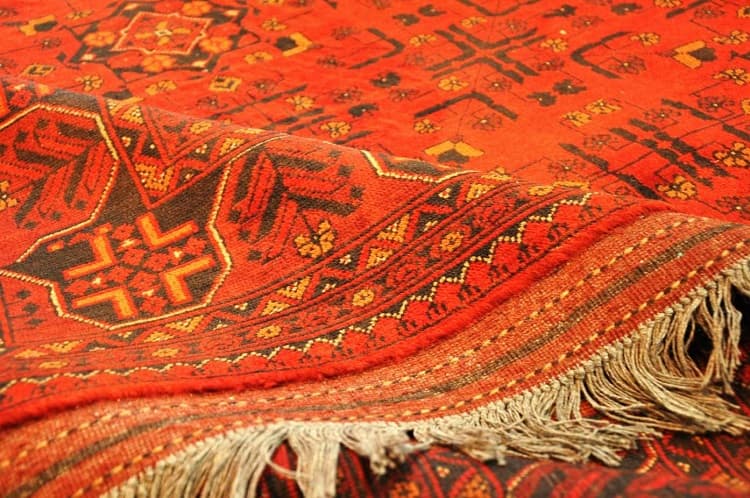If you have a persian or oriental rug that needs cleaning, then this article is for you.
I will be discussing how to properly clean these rugs and the preventative measures one can take to ensure they stay clean. These include using an area rug pad, often vacuuming with the appropriate attachment, keeping it away from direct sunlight, etc.
If you are interested in learning more about cleaning and caring for oriental rugs, make sure to read on.
Cleaning Oriental Area Rugs
There are many factors to consider when choosing the right rug cleaning method for your particular carpet. Here, we will examine how you can clean them yourself without damaging or altering their appearance in any way.
Check the label first

The label of an oriental area rug is one of the most important pieces of information you will need to determine how and what you should clean it with.
The best way to identify a genuine handmade oriental rug, especially if it’s vintage, is by looking for the maker’s label.
The label will most likely be located on the back of the rug, but it is sometimes found at one end. The label may also include information about what kind of fiber was used in the carpet’s construction and how much pile height is contained within each knot.
If you do not have a label or if your oriental rug does not contain any labels, then carefully examine its material composition to determine which cleaning method would work best for it.
Before beginning this process, please remember that all-natural fibers are different, so use these methods as guidelines only.
If in doubt, try out a small inconspicuous part of your rug first before proceeding with larger areas.
How to Clean Oriental Rugs at Home
Step 1 – Remove the loose dirt
Firstly, you should remove any loose dust particles or dirt. Use a vacuum cleaner with an upholstery attachment to gently suck away the small debris that is visible on both sides of your rug.
Step 2 – The fringes of the oriental rug shouldn’t be vacuumed
Do not vacuum the fringes of your oriental rug, as this can cause damage to them. The best way to clean these is by brushing gently with a natural bristle brush or using a handheld carpet sweeper without any rotating brushes.
To be on the safe side, it’s always advisable that you place paper towels between the fringe and cleaner before going ahead and cleaning in case anything gets sucked up into the motor area.
Step 3 – Dusting the rug
Now that you’ve vacuumed your rug, it is time to dust. Using another clean dry cloth, brush the surface of the oriental rug from one end to the other in a smooth and even motion until all dirt particles have been removed.
Related Reading: How to Clean Your Rug without Vacuum Cleaner.
Step 4 – Vacuum the rug once again
After you’ve brushed your rug, turn it over and vacuum the other side in the same way as before.
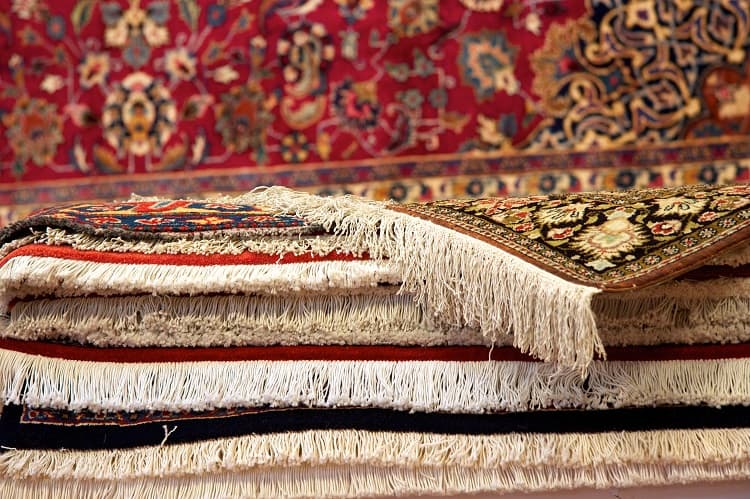
The best method for cleaning oriental rugs is by using a carpet sweeper to remove dirt from one end of the rug to another much like vacuuming would do, but without causing any damage or making large indentations on its surface.
Related Reading: Best Vacuums for Area Rugs.
Step 5 – Prep the cleaning area
Before you begin cleaning, read the label of your oriental rug to determine if it can be cleaned with water. If so, lay a thick towel over an area that is several feet larger than the circumference of the oriental rug and tape down all sides so as not to allow any water or cleaning solution to seep under its edges.
If there is no indication on your label about what kind of material has been used in construction, then we advise against using liquid cleaners because chances are they will contain chemicals that could erode away at natural fibers, which may lead them to become weak and brittle over time.
Step 6 – Wet the rug
Using a spray bottle filled with distilled water, dampen the top of your oriental rug. It is important not to wet it too much as this could cause the fibers within it to expand and swell, making them less dense and affecting their strength over time.
Spray approximately one square foot at a time or until you have covered all dirt spots evenly, then remove excess moisture by dabbing them gently with an absorbent cloth, being careful that you don’t rub in circles but instead move from side-to-side just like brushing teeth.
Step 7 – Shampooing the rug
In a separate bucket, mix up your shampoo by combining one part household all-purpose liquid cleaner with two parts distilled water. Test the solution on an inconspicuous area first to make sure it doesn’t cause any color changes or damage before going ahead and cleaning your oriental rug with it.
Remember that natural fibers are much more delicate than synthetic ones, so use light pressure when scrubbing as excessive force could lead them to become weak and brittle over time, causing them to discolor and become worn out faster.
Step 8 – Rinse and repeat the process
After you have finished shampooing your oriental rug, remove the excess moisture by dabbing it gently with an absorbent cloth and allow it to dry naturally in a well-ventilated area or outside if possible.
If you prefer not to use water, then alternative carpet cleaning solutions can be used on oriental rugs that will still effectively get rid of dirt but won’t harm its fibers over time.
Step 9 – Drying
An oriental rug should be dried at room temperature to prevent mold growth. When it is completely dry, shake the oriental rug out vigorously and brush once more using a natural bristle brush or with your handheld carpet sweeper without any rotating brushes.
Before you place an oriental rug back in its spot, make sure that all of the dirt has been removed; otherwise, over time, this could lead to discoloration along with the formation of ugly brown lines.
Now that you know how to clean an oriental rug, follow these steps every six months for best results.
How to Clean Oriental Rugs With Vinegar
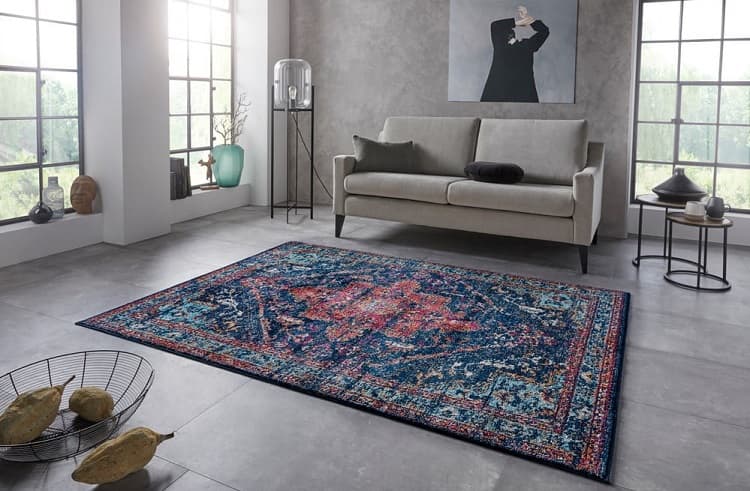
One of the most popular ways to clean oriental rugs is with vinegar. Vinegar has been used for centuries as a cleaner and disinfectant, so it stands to reason that adding some white or apple cider vinegar into your rug cleaning process will help you get great results. To use this method for how to clean an oriental rug:
- Mix one part vinegar to three parts water in a spray bottle.
- Spray the mixture onto your rug and scrub it into the fibers using an old toothbrush or similar item that you don’t mind getting dirty. You can also use this mix with other cleaning implements like sponges, but avoid abrasive brushes as they could damage delicate rugs.
- Rinse out your brush after each pass-through of the area you’re working on so you know how much dirt is coming off of the rug. This will help ensure that sugary liquids aren’t left behind when drying time rolls around later on.
- After scrubbing the area clean, remove as much of the liquid from your oriental rug with a wet/dry vacuum.
- Dry off any remaining moisture using an absorbent towel and allow your rug to air dry for several hours or overnight, making sure it is in a well-ventilated room so that no mold can grow during this time.
Related Reading: How to Clean Your Rug with Baking Soda?
How to Clean Stains
When you’re faced with stubborn stains, this is the best way to clean oriental rugs.
Mix one part white vinegar and two parts water in a spray bottle for this type of cleaning; if your stain is particularly tough, add more vinegar.
- Lightly mist the stained area on your rug and gently rub it into the fibers using an old toothbrush or sponge (no scrubbing.)
- Rinse out any remaining sugary liquid from your rugby, spraying it down with plain water after letting overnight dry naturally. This extra step will wash away sugars that might attract pests later on.
- Once completely dried off, vacuum up any remaining moisture before putting it back in place.
When to Get a Professional Cleaning
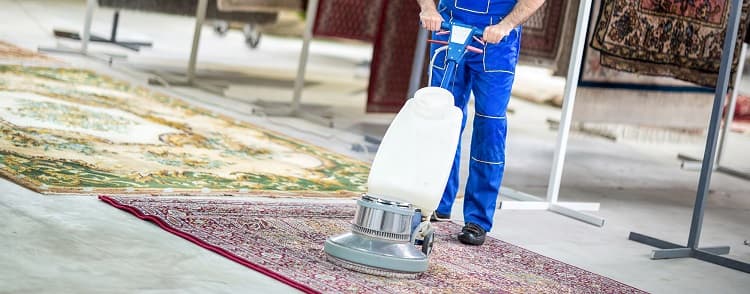
If you have a rare or expensive oriental rug, it’s best to leave the cleaning up to the professionals. This is especially true if your rug has been previously cleaned with chemicals- getting those residues out can be nearly impossible for someone without experience in this area.
To find a professional cleaner near you who works on oriental rugs and other types of floor coverings as well as furniture, check online or contact your local chamber of commerce.
You’ll want to take advantage of these services at least once per year so that any dirt build-up doesn’t damage the fibers over time due to excess weight from dust mites and human/animal dander (which could cause allergies.)
Preventative Measures and How to Care for Oriental Rugs
Don’t wash your oriental rug FREQUENTLY
Don’t over-dry your oriental rug. This can cause it to shrink or warp, ruining the look of a costly persian or oriental carpet.
Avoid using chemical cleaners on an oriental rug because they may deteriorate sensitive dyes in these rugs. Instead, clean them with water from a garden hose only if possible. Be sure to use cold water so as not to change their color too much. Never use hot water when cleaning an oriental rug. Hot water will set any stains you are trying to remove forever. It is best to allow organic matter such as soil and other types of dirt particles found in nature (e.g., grass, pollen) to dry out and naturally fall away from the pile of an oriental rug, which can take about two weeks or more depending on where you live.
Don’t leave your persian rug in direct sunlight
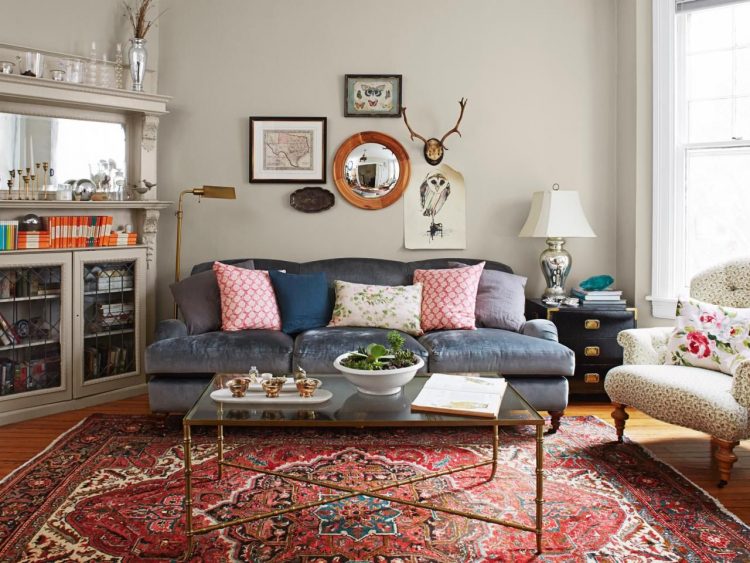
Don’t leave your persian rug in direct sunlight because it will fade the color of the oriental rug or cause a stain to appear. It is best to rotate an oriental rug frequently if you want to reduce fading and keep them looking new for years on end.
Do not use a steam cleaner unless absolutely necessary, as these cleaners can damage oriental rugs by losing their colors and/or leaving unsightly watermarks. These marks may be difficult—if not impossible—to remove from some types of oriental rugs, especially those with deep pile construction. In addition, do NOT place any hot items such as cups or plates directly onto your beautiful silk or wool carpet.
Never walk on an oriental rug with shoes on
Never walk on an oriental rug with shoes or any type of dirty bottomed footwear, as this will quickly ruin an expensive oriental carpet. Instead, be sure to use a few inexpensive throw rugs around the house where you typically enter and exit in order to protect your most valuable persian Rugs from getting ruined by dirt and dust.
If you have children that are crawling babies or toddlers, it may be best if they avoid stepping on these types of costly carpets, too, because their feet could leave marks over time. In addition, try placing furniture pads underneath all tables and chairs so as not to scratch precious silk or wool oriental rugs beneath them while moving about the room.
Place a rug pad underneath an oriental rug
Place a Rug Pad underneath your oriental rugs for increased cushioning and to help preserve the life of expensive silk or wool carpets. Though they are typically more costly than the regular bathroom, kitchen type carpet tiles, these types of floor pads will keep an oriental rug in place while protecting it from damage over time because you won’t have to worry about shifting its position.
Clean oriental rug for dust
Frequently clean persian rugs for dust to keep them looking new. Use a vacuum cleaner with a brush attachment, which will help lift dirt and other particles away from the pile where it belongs. Be sure not to apply too much pressure on your oriental rug, or you may cause permanent damage that can’t be reversed.
Avoid letting small children eat snacks while sitting directly upon an oriental carpet because crumbs could fall between its fibers over time, leaving unsightly marks in their wake. Instead, try placing several throw pillows around the room, so they have something safe to sit on when enjoying meals. This way, any spills will hopefully end up onto these soft cushions rather than persian carpets beneath them—a win-win situation for everyone.
Rotate your rug every now and then
Rotate your oriental rug every now and then to help reduce fading. This way, you won’t have to worry about placing two of them near one another over time, resulting in some ugly uneven lines forming on the surface.
Wrap your oriental rug in plastic to store
Wrap your oriental rug in plastic when you are storing it for an extended period of time. This will help keep out any humidity or moisture that could cause molding or mildew stains on the surface if left untreated.
Vacuum oriental rug regularly
Vacuum persian rug regularly to avoid dust and dirt that can cause staining if left untreated. Use a brush attachment with your vacuum cleaner, which will help you get into the fibers of the oriental rug without causing any damage or wear over time.
FAQ
How Much Does It Cost to Clean a Persian Rug?
It can cost anywhere from $75 on up. This will depend on the size of your rug and how many pieces it has and whether or not you have fringe. If you do, be sure to let us know, so we don’t accidentally cut those off.
In most cases, a rate starts at around $95 for an average-sized room-sized oriental rug without any fringes. However, the price will go down if it’s in worse condition when you bring it in because there are different rates depending upon its condition before cleaning.
The specific prices are based largely on location since labor costs vary both by region and city/township – but also because some cities tend to charge more than others to do the same work. If you’d like, we can give you a more specific quote after checking your rug’s condition and size so that you’ll know how much it will cost ahead of time before we begin cleaning.
How Often Should Persian Rug Be Cleaned?
That depends on the specific type of rug. If you have a silk or wool oriental, it’s best to get them cleaned every year, so they don’t become damaged from being too dirty for too long. For synthetic rugs, however – which are largely made up of nylon and polyester- we suggest getting that done about twice a decade if possible because those more durable materials can go longer without needing help cleaning than silk or wool would. A good rule of thumb is to clean your persian based upon how much foot traffic there is in the room where it lives since this will impact its condition over time as well as how often it needs attention.
Can Persian Rugs Be Steam Cleaned?
No, Persian rugs should never be steam cleaned. It can damage your rug and warp its shape. No, you cannot wash an oriental rug in a washing machine unless it specifically says on the tag that it’s okay to do so (most likely, this will not be the case.)
Can You Clean the Fringe on an oriental rug?
You should never use soap or water to clean the fringe on your rug. It’s best to let it dry naturally and vacuum up any loose dirt.
Can You Use a Carpet Cleaner on Area Rugs?
No, you should never use a carpet cleaner on your oriental rug. It can warp and distort the shape of your rug and cause discoloration.
Final Word
An oriental rug is a timeless piece of art. It’s best to leave it alone and make sure you keep up with regular vacuuming. If something spills on your rug, spot clean as quickly as possible.

